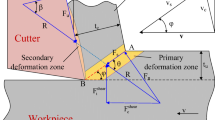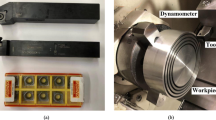Abstract
The shear angle is one of the important factors in cutting deformation and the shear angle theory reveals the relationship between the shear behavior in the primary zone and the tool-chip friction behavior in the secondary zone. In order to deepen the understanding of shear angle theory, the study investigated the shear angle variation in aluminum alloy Al6061-T6 and compared the three conventional shear angle models, Merchant, Lee and Shaffer, and Hucks. To obtain the shear angle more conveniently, a simple approach utilizing the connection between the shear angle and chip thickness was proposed. Orthogonal cutting experiments were conducted on aluminum alloy Al6061-T6. A new cutting simulation model for shear angle and chip thickness of Al6061 with errors below 15% and 10% respectively was proposed in the study. What’s more, it was found that the three shear angle models have their applicable ranges in cutting speed for the aluminum alloy. It is mainly because the internal friction coefficient of workpiece material decreased as cutting speed rose.
Similar content being viewed by others
References
Merchant ME (1945) Mechanics of the metal cutting process. I. Orthogonal cutting and a type 2 chip. J Appl Phys 16(5):267–275. https://doi.org/10.1063/1.1707586
Lee EH, Shaffer BW (1951) The theory of plasticity applied to a problem of machining. J Appl Mech-T ASME 18(4):405–413
Shaw MC (2005) Metal cutting principles. Oxford University, Oxford
Deng WJ, Li Q, Xie ZC, Lin P (2013) Numerical analysis of rectangular groove cutting with different RC tools. Int J Simul Model 12(2):120–131. https://doi.org/10.2507/IJSIMM12(2)5.243
Tamizharasan T, Kumar NS (2012) Optimization of cutting insert geometry using Deform-3D: numerical simulation and experimental validation. Int J Simul Model 11(2):65–76. https://doi.org/10.2507/IJSIMM11(2)1.200
Simunovic G, Simunovic K, Saric T (2013) Modelling and simulation of surface roughness in face milling. Int J Simul Model 12(3):141–153. https://doi.org/10.2507/IJSIMM12(3)1.219
Saric T, Simunovic G, Simunovic K (2013) Use of neural networks in prediction and simulation of steel surface roughness. Int J Simul Model 12(4):225–236. https://doi.org/10.2507/IJSIMM12(4)2.241
Sekar KSV, Kumar MP (2012) Optimising flow stress input for machining simulations using Taguchi methodology. Int J Simul Model 11(1):17–28. https://doi.org/10.2507/IJSIMM11(1)2.195
Lee WB, To S, Sze YK, Cheung CF (2003) Effect of material anisotropy on shear angle prediction in metal cutting—a mesoplasticity approach. Int J Mech Sci 45(10):1739–1749. https://doi.org/10.1016/j.ijmecsci.2003.09.024
Kovrizhnykh AM (2009) Determining the shear angle, forces, and sizes of shearing elements during metal cutting. J Appl Mech Tech Phys 50(1):147–154. https://doi.org/10.1007/s10808-009-0020-3
Zhou L, Peng FY, Yan R, Yao PF, Yang CC, Li B (2015) Analytical modeling and experimental validation of micro end-milling cutting forces considering edge radius and material strengthening effects. Int J Mach Tool Manu 97:29–41. https://doi.org/10.1016/j.ijmachtools.2015.07.001
Sutter G (2005) Chip geometries during high-speed machining for orthogonal cutting conditions. Int J Mach Tool Manu 45(6):719–726. https://doi.org/10.1016/j.ijmachtools.2004.09.018
Sutter G, List G (2013) Very high speed cutting of Ti–6Al–4V titanium alloy–change in morphology and mechanism of chip formation. Int J Mach Tool Manu 66:37–43. https://doi.org/10.1016/j.ijmachtools.2012.11.004
Xu DC, Feng PF, Li WB, Ma Y, Liu B (2014) Research on chip formation parameters of aluminum alloy 6061-T6 based on high-speed orthogonal cutting model. Int J Adv Manuf Technol 72(5–8):955–962. https://doi.org/10.1007/s00170-014-5700-3
Aksu B, Celebi C, Budak E (2016) An experimental investigation of oblique cutting mechanics. Mach Sci Technol 20(3):495–521. https://doi.org/10.1080/10910344.2016.1196458
Lauro CH, Ribeiro SLM, Brandao LC, Davim JP (2016) Analysis of behaviour biocompatible titanium alloy (Ti-6Al-7Nb) in the micro-cutting. Measurement 93:529–540. https://doi.org/10.1016/j.measurement.2016.07.059
Lee WB, Wang H, Chan CY, To S (2013) Finite element modelling of shear angle and cutting force variation induced by material anisotropy in ultra-precision diamond turning. Int J Mach Tool Manu 75:82–86. https://doi.org/10.1016/j.ijmachtools.2013.09.007
Gao D, Hao ZP, Han RD, Chang YL, Muguthu JN (2011) Study of cutting deformation in machining nickel-based alloy Inconel 718. Int J Mach Tool Manu 51(6):520–527. https://doi.org/10.1016/j.ijmachtools.2011.02.011
Xie J, Luo MJ, Wu KK, Yang LF, Li DH (2013) Experimental study on cutting temperature and cutting force in dry turning of titanium alloy using a non-coated micro-grooved tool. Int J Mach Tool Manu 73:25–36. https://doi.org/10.1016/j.ijmachtools.2013.05.006
Sun JL, Zhou YH, Deng JX, Zhao J (2016) Effect of hybrid texture combining micro-pits and micro-grooves on cutting performance of WC/Co-based tools. Int J Adv Manuf Technol 86(9–12):3383–3394. https://doi.org/10.1007/s00170-016-8452-4
Xu DC, Feng PF, Li WB, Ma Y (2015) An improved material constitutive model for simulation of high-speed cutting of 6061-T6 aluminum alloy with high accuracy. Int J Adv Manuf Technol 79(5–8):1043–1053. https://doi.org/10.1007/s00170-015-6888-6
Lin JQ, Han JG, Zhou XQ, Hao ZP, Lu MM (2016) Study on predictive model of cutting force and geometry parameters for oblique elliptical vibration cutting. Int J Mech Sci 117:43–52. https://doi.org/10.1016/j.ijmecsci.2016.08.004
Bai W, Sun RL, Gao Y, Leopold J (2016) Analysis and modeling of force in orthogonal elliptical vibration cutting. Int J Adv Manuf Technol 83(5–8):1025–1036. https://doi.org/10.1007/s00170-015-7645-6
Hase A, Wada M, Koga T, Mishina H (2014) The relationship between acoustic emission signals and cutting phenomena in turning process. Int J Adv Manuf Technol 70(5–8):947–955. https://doi.org/10.1007/s00170-013-5335-9
Ke QC, Xu DC, Xiong DP (2017) Cutting zone area and chip morphology in high-speed cutting of titanium alloy Ti-6Al-4V. J Mech Sci Technol 31(1):309–316. https://doi.org/10.1007/s12206-016-1233-z
Xu DC, Feng PF, Li WB, Xu C, Ma Y (2016) A friction model having multiple factors for high-speed cutting of aluminum alloy 6061-T6. Int J Adv Manuf Technol 84(9–12):1941–1951. https://doi.org/10.1007/s00170-015-7847-y
Acknowledgements
We thank Melissa Gibbons, PhD, from Liwen Bianji, Edanz Editing China (www.liwenbianji.cn/ac), for editing the English text of a draft of this manuscript.
Funding
This work was supported by the National Natural Science Foundation of China (51875045).
Author information
Authors and Affiliations
Corresponding author
Rights and permissions
About this article
Cite this article
Hao, M., Xu, D. & Feng, P. Numerical and experimental investigation of the shear angle in high-speed cutting of Al6061-T6. Int J Adv Manuf Technol 100, 3037–3044 (2019). https://doi.org/10.1007/s00170-018-2842-8
Received:
Accepted:
Published:
Issue Date:
DOI: https://doi.org/10.1007/s00170-018-2842-8




